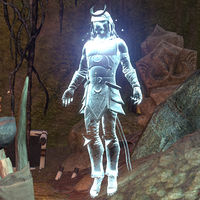Lore:Rid-Thar-ri'Datta
| Mane Rid-Thar-ri'Datta | |||
|---|---|---|---|
 Mane Rid-Thar-ri'Datta Mane Rid-Thar-ri'Datta
|
|||
| Race | Khajiit | Gender | Male |
| Born | 2nd Era |
||
| Resided in | Elsweyr | ||
| Previous Ruler | Position Established | ||
| Appears in | ESO | ||
Rid-Thar-ri'Datta was the Mane of Elsweyr during the early-mid Second Era. Rid-Thar-ri'Datta is referred to as the first Mane,[1] a spiritual leader of Elsweyr that paved the way for a moon-based culture and veneration for the deity of cosmic order, the Riddle'Thar.[2]
History[edit]
Lifetime[edit]
Rid-Thar-ri'Datta was born sometime in the early Second Era, under the Dark Moons which dictates the birth of the Mane.[3] Rid-Thar became a prominent figure in the early-mid fourth century, somewhat contemporary with the formation of the Elsweyr Confederacy in 2E 309.[4] While he is referred to as "the First Mane" by the Khajiit, this is only true for the Elsweyr Confederacy itself, as there have been documented Manes from the time before the unification of the Sixteen Kingdoms.[5]. In 2E 311, Rid-Thar-ri'Datta revealed the Riddle'Thar Epiphany during a visit to the Temple of Two-Moons Dance in Rawl'kha. The revelation has been described as a key event in modern-day Khajiiti theology.[6] Following the sacking of Ne Quin-al and the slaughter of the royal dynasty in 2E 326,[7] the province of Elsweyr was in disarray. Peace was restored with the intervention of Rid-Thar-ri'Datta when he "bestowed to the classes equality under the bi-lunar shadow, dividing their power in accordance with two-moons-dance of the ja-K'hanay." With this set in motion, the rankings in the caste system shifted control between each other depending on the phases of the Two-Moons. (Masser and Secunda) The Mane had become the total leader of Elsweyr ever since.[4]
The mane's religious reforms came with its fair share of controversy. However, temples affiliated with the Riddle'Thar cult would also rise and scrub many of the spirits from the Khajiit pantheon,[8] and persecuted those that did not comply. Examples include temples such as the Shrine of the Consummate S'rendarr, which refused to follow this new edict and were banished from society and subsequently deconsecrated.[9] Some believe that when Riddle'Thar guided Khajiit along his one true path of the moons, he hid Khajiit from other viable paths.[10] Additionally, some believe that he usurped rich traditions with flimsy ones, and "sanded down the sharper edges of Khajiiti theology."[11] Some modern Khajiit that uphold the Riddle'thar consider ancient Khajiit religion dangerous, due to the fact that much of it was created during the time that Khajiit held scattered beliefs. Sixteen different faiths competed against each other, which "tumbled and scratched their way through history, competing for the souls of all Khajiit." However, this has not stopped Khajiit from seeking out the knowledge of the ancient beliefs that had been displaced.[12]
The Dark Mane & Reaper's March[edit]
During the Interregnum in 2E 582, the Mane of Elsweyr, Akkhuz-ri had become possessed through Javad Tharn's manipulation and the influence of the Dro-m'Athra. His lunar champions, Khali and Shazah were forced to fight back against the invading Dro-m'Athra and the Imperial Legion from the West Weald. To guide them in their process of becoming Mane, Rid-Thar appeared before them and their ally in Fort Grimwatch. He deemed that Akkhuz-ri was no longer able to serve as Mane, and so bestowed the champion's ally the title of "Moon Hallowed."[13]
Rid-Thar later appeared before the Moon Hallowed at the Do'Krin Monastery, where the Stonefire Cult massacred the Order of the Claw for the eponymous artifact, the Golden Claw. The two entered the temple and were able to defeat the cult before they could acquire the claw.[14] At the temple of Moonmont, the Mane reunited with the Moon Hallowed and the Lunar Champions, before they had to encounter the Dark Mane and seal him away. The Mane gave the Hallowed the choice between which of the twins had to imprison the Dark Mane while the other became the Mane. It is unknown who they chose, but the Dark Mane was sealed. Finally, Rid-Thar met the Moon Hallowed and Lunar Champion while they walked the Two Moons Path[15] and confronted both Javad Tharn and the Dark Mane again. After their victory, Rid-Thar-ri'Datta gave his blessing for the new Mane of Elsweyr.[16]
Notes[edit]
- It is implied that Rid-Thar-ri'Datta is connected to royalty through the ri'Datta Dynasty, which may have started from him. The Khajiiti deities, Alkosh and Lorkhaj are described as "Pre-ri'Datta Dynasty Anequinine deities."[2] This information is further supported when Alkosh's mountain temple, Sunspire had lost significance after Rid-Thar-ri'Datta's epiphany in Rawl'kha and the shifted worship towards Riddle'Thar.[17]
- There is an artifact known as the Ring of Rid-Thar-ri'Datta that is kept by the clergy in Moonmont. It is valuable for spiritual reasons but it is also a highly lucrative item of interest.[18]
References[edit]
- ^ Shazah's dialogue in ESO
- ^ a b Varieties of Faith: The Khajiit — Brother Mikhael Karkuxor of the Imperial College
- ^ Envoy Cashia's dialogue in ESO: Elsweyr
- ^ a b Pocket Guide to the Empire, 1st Edition: The Elsweyr Confederacy — Imperial Geographical Society, 2E 864
- ^ Mane Jinninji-ri and Mane Zebiden-jo, who both held the title before Rid-Thar-ri'Datta
- ^ Rawl'kha Temple loading screen in ESO
- ^ Anequina and Pellitine: An Introduction — Sulema, Initiate Scholar of the Pa'alatiin
- ^ Shrine of Boethra furnishing codex from ESO
- ^ Claw's Strike loading screen in ESO
- ^ Moongrave Fane loading screen description in ESO: Scalebreaker
- ^ Vastarie's dialogue in ESO: Elsweyr
- ^ Epistle on the Spirits of Amun-dro — Thava-ko
- ^ Grim Situation quest in ESO
- ^ The Golden Claw quest in ESO
- ^ The Moonlit Path quest in ESO
- ^ The Den of Lorkhaj quest in ESO
- ^ Sunspire loading screen in ESO: Elsweyr
- ^ Jurak-dar's dialogue in ESO